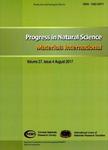Production of human lysozyme-transgenic cloned porcine embryos by somatic nuclear transfer
Production of human lysozyme-transgenic cloned porcine embryos by somatic nuclear transfer作者机构:State Key Laboratory for Agrobiotechnology and Department of Animal Physiology College of Biological Science China Agricultural University No. 2 Yuan-Ming-Yuan West Road Beijing 100094 China Ji Pulin Biotech Ltd Beijing 100094 China
出 版 物:《Progress in Natural Science:Materials International》 (自然科学进展·国际材料(英文))
年 卷 期:2009年第19卷第6期
页 面:699-704页
核心收录:
学科分类:08[工学] 09[农学] 0901[农学-作物学] 0836[工学-生物工程] 090102[农学-作物遗传育种]
基 金:supported by the Natural Science Foundation of Beijing (5030001) National 948 Program (2006-G59)
主 题:EGFP Porcine Nuclear transfer Fetal fibroblast Human lysozyme (HLY)
摘 要:Due to their physiology and organ size, pigs have significant potential as human disease models and as organ transplantation donors. Genetic modification of pigs could provide benefits for both agriculture and human medicine. In this study, five fetal pig fibroblast cell lines from two species (Wuzhishan and Landrace pigs) were transfected using double-marked human lysozyme (HLY) plasmids (pBC1-HLY-GFP-NEO) by a liposome-mediated method. The ratio of green fluorescent protein (GFP)-expressing cells was 95% in sw7, sw8, slw3 and slw6 cell lines, but only 49.3% in slw9 cells. Cells from the four highly transgenic lines were used as nuclear donors to construct embryos, which were then cultured after fusion and activation by electric stimulation. The rate of cleavage was 76.7%, 48 h after activation. After 7 days, 18.5% of cleaved eggs had developed to the blastocyst stage and 93.3% of blastocysts were GFP-positive. These results indicate that transgenic fetal pig flbroblast cell lines could be obtained by a liposome-mediated method, though the transfection efficiency varied between cell lines. Reconstructed embryos derived from transgenic cells could successfully develop into blastocysts, most of which were GFP-positive.



